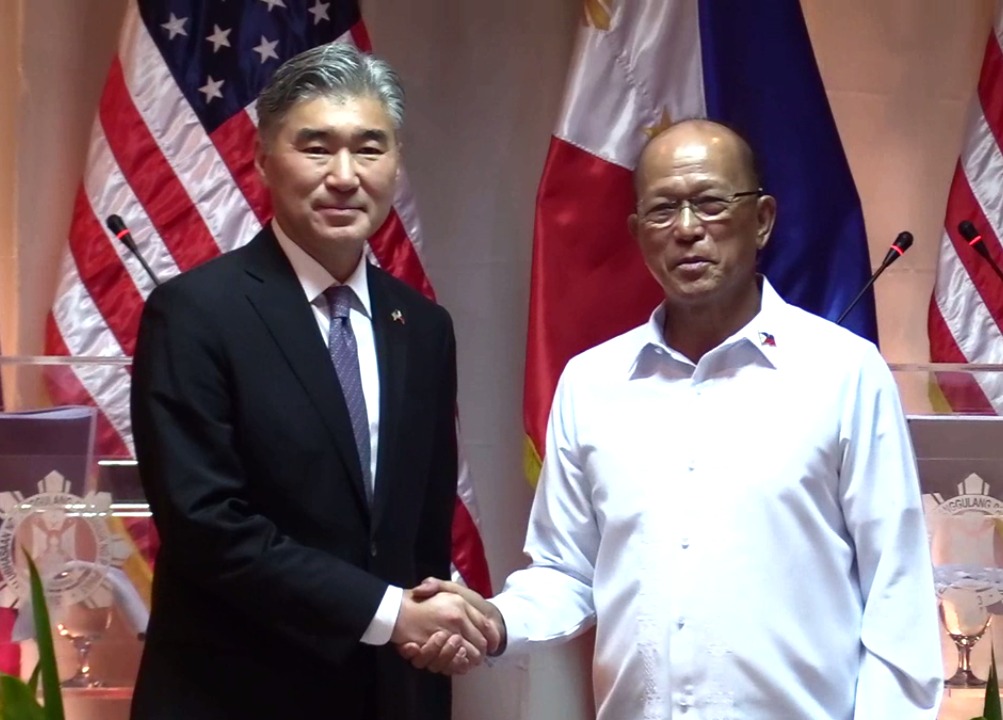
US ambassador to the PH Sung Kim and Defense secretary Delfin Lorenzana during the US & PH gov’t joint presscon on the recently completed Tempest Wind drill in Camp Aguinaldo on Tuesday, Sept 26, 2017. Photo by Ryan Leagogo/INQUIRER.net
US and Philippine forces have staged an exercise simulating the seizure of an American plane by Islamic State (IS) and a hostage rescue, as they look to refocus their military alliance toward counterterrorism.
The five-day training exercise, which ended Tuesday, was the first of its kind and saw more than 400 troops, airport police and hostage negotiators create a mock hijack of a plane by an IS cell that forced it to land at Clark, a former US Air Force base.
Defense Secretary Delfin Lorenzana said the drill was in line with President Rodrigo Duterte’s wish to refocus the two countries’ 1951 mutual defense pact toward counterterrorism and disaster relief.
Since coming to power, Mr. Duterte sought to weaken ties with the country’s former colonial ruler and pivot toward China and Russia. He previously said military exercises with America were a “humiliation” for the Philippines and threatened to sever defense ties completely.
Relevance
He has since banned the Philippine military from conducting joint patrols with the US Navy outside Philippine waters and trimmed the number of joint military exercises.
The latest drill was held in the shadow of a US-backed military campaign to retake Marawi City, which was occupied by pro-IS gunmen more than four months ago.
“(It) served as a perfect opportunity to assess the needs of the new security environment in the Pacific region, especially now that terrorism has become evident in our current security landscape,” Lorenzana said.
Both governments stressed there was no such known plot against aircraft by IS or its supporters.
The last hijacking in the Philippines was in May 2000, when a passenger armed with a grenade and handgun tried in vain to force a Manila-bound Philippine Airlines flight to return to Davao City.
Philippine and US authorities said the drills were meant to establish “communication and coordination.”
In a ceremony marking the end of the exercises at the National Defense College inside Camp Aguinaldo, Lorenzana said “it is not only a military exercise.”
The drills included civilian agencies from both the United States and Philippine governments.
“The drill was designed to provide realistic scenarios and terrorism that demand both high-level engagement from these countries on a tactical level,” said Lorenzana.
‘Preparedness’
This year’s Tempest Wind drill, held from Sept. 18 to 26, involved a scenario where a Hawaii-bound flight from Sydney, Australia, was hijacked and forced to land at Clark by an IS cell. Up to 1,200 US and Philippine troops took part in it.
In the same ceremony, US ambassador to the Philippines Sung Kim said Tempest Wind “presented an unprecedented opportunity for comprehensive training for both senior leaders and action officers.”
Meanwhile, a counterterrorism expert said Tempest Wind was a venue for “whole-of-government approach to crisis resolution.”
Col. Edgard Arevalo, Armed Forces of the Philippines’ public affairs chief, said although he sees no hijacking “forthcoming or happening in the Philippines” the exercises were “all part of preparedness, of readiness for us.”
Tempest Wind is held every three years in the Philippines, providing realistic terrorist scenarios. —AFP and Jeannette I. Andrade